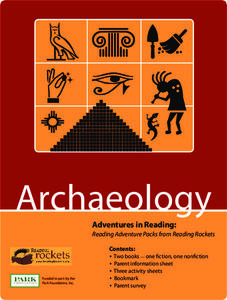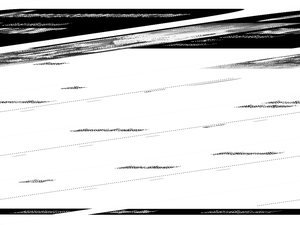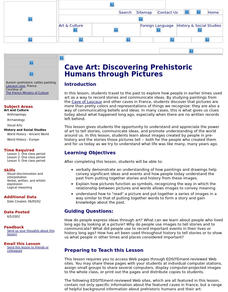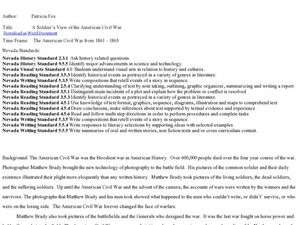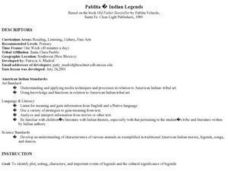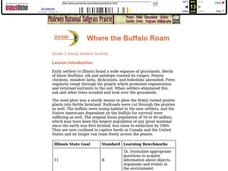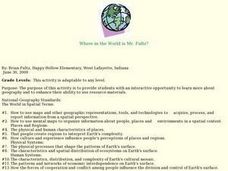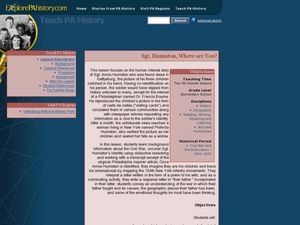PBS
Reading Adventure Pack: Archaeology
Readings of fiction and nonfiction texts followed by a series of activities put scholars in an archaeologist's shoes. Learners read two texts, Archaeologists Dig for Clues by Kate Duke and The Shipwrecked Sailor: An Egyptian Tale with...
Curated OER
Guided Reading: Family Picnic
Students blend phonemes. For this guided reading lesson, students create words by blending isolated phonemes. Students read a book discussing families.
Curated OER
Introducing Vocabulary: Christopher Columbus (Weinberger)
The story of Christopher Columbus has fascinated young historians for centuries; use this vocabulary-in-context strategy to dive into Kimberly Weinberger's picture book about this classic explorer. Begin by introducing the new words:...
Curated OER
Cave Art: Discovering Prehistoric Humans through Pictures
Students explore how people in earlier times used art as a way to record stories and communicate ideas by studying paintings from the Cave of Lascaux and other caves in France. Three lessons on one page.
PBS
Cemetery Information
Cemeteries hold a lot of clues for history detectives. Using the provided outline as a guide, scholars research tombstones and inscriptions to learn more about those who came before.
Curated OER
Cave Art: Discovering Prehistoric Humans through Pictures
Students understand how to "read" a picture and put together a series of images in a way similar to that of putting together words to form a story and gain knowledge about the past.
Curated OER
A Soldier's View of the American Civil War
Study and research the American Civil War in this explanatory writing lesson. Middle schoolers complete six activities to learn about the American Civil War and soldiers' views of the war. The lesson includes several options to complete...
Curated OER
Yo Ho, Yo Ho, A Pirate's Map for Me: An Original Story
Students read Blackbeard and brainstorm their knowledge of maps. In this language arts and geography instructional activity, students use landmarks on their playground to review north, south, east and west and discuss the compass rose....
Smithsonian Institution
George Washington: A National Treasure
Uncover the answer to a specific clue in a portrait of George Washington with a spyglass in an Internet-based interactive. Learners read a clue to an item hidden in a portrait of the First President of the United States in the last years...
Curated OER
How to "Read" an Artifact
Pupils discuss the types of information they can get from artifacts. In groups, they practice "reading" artifacts and determining their usage. They use inferences to test against official information about certain pieces. They also...
Curated OER
Pablita Indian Legends
Scholars are introduced to the characteristics of a legend. They read and discuss Old Father Story Teller by Pablita Velarde. Then, in groups, they write and illustrate a poem based on one of the legends from the book. This lesson plan...
Curated OER
Reading Primary Source Documents: Comparing Sources
Students analyze and compare various primary source documents. They formulate historical questions based on the documents.
Curated OER
Traveling Through Literature
Integrate geography with literature in this interdisciplinary instructional activity. Begin by reading a poem such as The Time We Climbed Snake Mountain by Leslie Marmon Silko. On a large map, place push pins in the cities or states...
Curated OER
Early English Settlement
Fifth graders encounter the TCI History Alive Assessment. Create a rubric together with other students. Use graphic organizers to brainstorm challenges that one would face attending school in a foreign country.
Curated OER
Letters From Rifka
Small groups read assigned chapters from the book, Letters to Rifka, then work together to fill out comprehension worksheets associated with their chapters. This fine, 13-page lesson culminates with each group getting together to meet...
Curated OER
The Legend of the Blue Bonnet
Learners complete pre reading, writing, during reading, and interdisciplinary activities for the book The Legend of the Blue Bonnet. In this reading lesson plan, students complete journal entries, go over vocabulary, answer short answer...
Curated OER
The 44th and 45th USA Presidents
The transition of power between former President Barack Obama and President Donald Trump may be the first political process that your students have followed. Fill out the details between these two leaders with a set of vocabulary...
Curated OER
Homes of the West
Fourth graders read about homes in Utah over time and design models of the homes. In this homes of the west lesson, 4th graders draw and label five homes that existed in the west. Students research each home and gather information...
Curated OER
Social Studies - Guessing Game
Focus on a particular geographic location with this resource. Learners use their social studies textbook to look up information about a specific place. They write down a list of facts and read them to the class. Classmates guess which...
Curated OER
Where the Buffalo Roam
Second graders explore what life in the Chicago area was like hundreds of years ago. They discuss how settlers impacted the environment, and why there are no longer herds of buffalo in the Chicago area today. They read an article and...
Curated OER
Learning About Maps
Students take a "field trip" with the teacher through the school then draw a diagram of what they saw. They bring the maps to the computer lab where they create electronic maps using the software program Neighborhood Map Machine.
Curated OER
Where in the World is Mr. Fultz?
Students use maps and other geographic resources to learn about their world while problem solving. They read clues each day and use classroom resources to narrow down where the prize is located.
Curated OER
Friendship
First graders explore human psychology by reading a book in class. In this friendship lesson, 1st graders identify the benefit of friends and strong relationships while reading the book The Rainbow Fish. Students analyze the images from...
Curated OER
Sgt. Humiston, Where are You?
Students become familiar with the events of the Civil War. In this identification lesson plan, students use deductive reasoning to understand how the deceased soldier was identified. Students view primary documents for...
